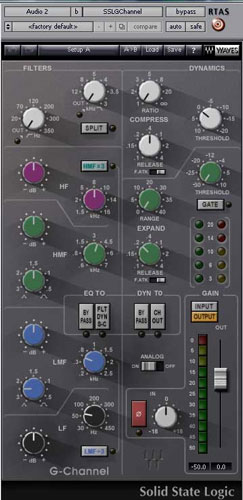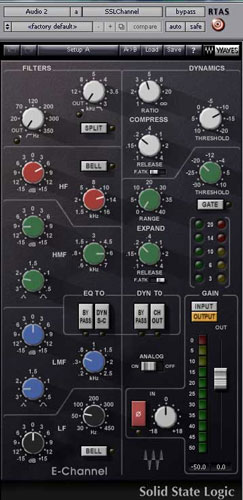Stay Up To Date With Us!
We will never spam you or share your email address.
Game Sound Design Strategies
GSD StrategiesCheck out the gamesounddesign.com strategies when you are feeling creatively uninspired. Each random strategy will present you with a new avenue to pursue. Give them a try!
Game Sound Design Glossary
GSD GlossaryOur game audio glossary has all the sound terms you have been wondering about. Game audio can be confusing enough without having to deal with a new technical language. We are constantly updating the database with new terms that relate to not only game audio but game developer terms as well.
Review: Waves Solid State Logic 4000 Plugins
Review by George Spanos
The Waves Solid State Logic 4000 plugin collection is part of the Waves Modeling Series bundles. The suite is based on the legendary SSL 4000 series console and features the SSL E-Channel, the SSL G-Master Buss Compressor, the SSL G-Equalizer, and the new G-Channel. According to Waves these plugins sound so close to the original that even experts who have worked with the hardware versions of these plugins cannot tell the difference.
Well, with such an affirmative stance on their modeling I just had to check this series out for myself... and I was quite surprised by the results. So how do the plugins sound? Is the collection worth the price of admission? Read on to find out.
Solid State Logic is a world renowned British manufacturer of audio consoles. SSL consoles are considered to be among the best sounding audio devices available and legacy models are still highly sought-after.
First of all, let me tell you that this article will not be full of the usual tech-head mumbo-jumbo. I am not a fan of reading reviews about products that only quote me stats and figures. As a user, all I am truly interested in is the direct application of the product and how it sounds. After all, what good is a bunch of technical stats when trying to explain to your client how this piece of gear will improve their production. Tell me what this piece of audio gear can do for me and the projects I work on by describing in detail, the sound possibilities that I can expect from the device.
That being said, here is a very quick rundown, from Waves, of each plugin's technical design:

SSL G-Channel
This plugin consolidates the equalization and dynamic control of the SSL G Series consoles into one tool. Together, they deliver the sound and convenient routing flexibility of the SSL G-series consoles.
SSL G-Equalizer
This four band equalizer, modeled on the SSL G Series EQ292, offers greater gain change than the E-Series EQ and a slightly different curve. The SSL G-Equalizer includes a pre-boost dip and a pre-cut rise, as well as a broader Q (bandwidth) for more extreme equalization.
SSL G-Master Buss Compressor
Based on the renowned master buss center compressor of the SSL 4000 G console, the SSL G-Master Buss Compressor captures the sound of its IC input and twin VCA gain-reduction amplifier design.
SSL E-Channel
The SSL E-Channel delivers the sound of the SSL 4000 series console's all discrete design and its Class A, VCA chip.
Ok, so that all seems good. But how do they actually sound?

SSL G-Channel
The G-Channel is essentially that, an entire console strip complete with equalization, compression, gating, expansion, phase, and gain controls.
Music
I first started using the G-Channel on some of my music pieces. The plugin performed really well when I had to carve out a really low mid frequency hump in the acoustic guitar that I had recorded. I was able to finely extricate the offending frequencies and boost the "sheen" of the acoustic guitar's sound... really easily. That's a really important realization that I came across while using the whole suite of plugins? they are really effortless in their ease of use and the ability to achieve the sound you are seeking is really really effortless.
Sound Design
While this plugin may be overkill on a sound effects track, it did provide some really useful equalization and level control abilities. This channel's equalization section is very nearly identical to the separate G-Equalizer with the difference being that the high and low pass filters do not feature discrete boost and cut controls... not that those are missed necessarily, but would have been an added bonus (there is a separate low filter section that does have a separate boost and cut knob, however). The compression stage is very smooth and I was able to achieve the results I needed with a little coaxing.
It is interesting to note that there is not a separate attack time setting on the compression stage. Instead, the user has a choice of either a "fast" or an auto detect feature which will adjust the compressor's attack time by analyzing the incoming waveform. This function works great in music applications, though in sound design and sound effects editing more precise control may be needed.

SSL E-Channel
Much like the G-Channel, the E-Channel comes complete with equalization, compression, gating, expansion, phase, and gain controls.
Music
The E-Channel really worked well on electric bass in my tracks. Again, with the equalization section I was able to fine tune the strong points of the bass and eliminate the offending "roundness" that had been recorded. The slight amount of compression that I applied really was able to tame the "spikiness" of the bass. Drums also benefitted greatly from this channel strip. Carving out the frequencies needed to make the kick drum "pop" and add sizzle to the snare really improved on the drum kit's original recorded sound.
Sound Design
The E-Channel very closely matches the G-Channel in appearance, except for the color of the plugin. It operates in much the same way as the G-Channel except that the equalization section is modeled after a different version of the hardware unit found on the SSL 242 EQ. My comments about the equalizer and dynamics section are much the same as for the G-Channel.

